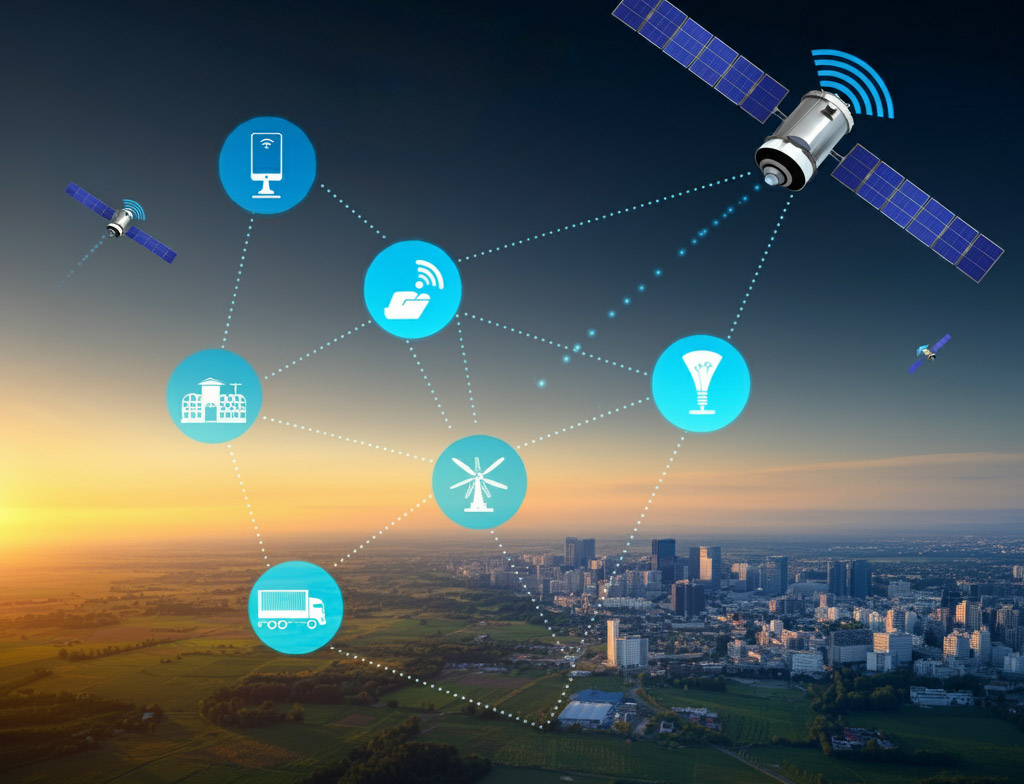
WASHINGTON – The remarkable success to date of SpaceX’s Starlink 6,000-satellite broadband constellation is driving significant changes across the industry, including consolidation, vertical integration, digital transformation and the embrace of partnerships to facilitate and multi-orbit offerings.
Satellite operators of all stripes are feeling the competitive pressure of Starlink, which some experts say offers a user experience that more closely resembles terrestrial 4G services than satellite. The good news, operators say, is that Starlink’s arrival, with more low Earth orbit (LEO) constellations entering service or on the way, is spurring innovation while raising the profile of the satellite sector in general.
“The influx of LEO providers and other “new space” industry entrants is bringing a great deal of awareness and excitement to the space industry overall,” David Wajsgras, chief executive of longtime geostationary-orbit (GEO) satellite operator Intelsat, said in a written response to questions. “At Intelsat, we’ve expedited the pace of our innovation. We’re establishing key partnerships, launching new products, and advancing our software-defined 5G network, including virtualizing our ground and space assets.”
Eva Berneke, chief executive of Paris-based Eutelsat Group, operator of a GEO constellation as well as the 630-satellite OneWeb LEO constellation, said the new competitive environment has driven her company to adapt more quickly than otherwise would have been the case. “This includes leveraging our strengths in geostationary satellites and integrating with the OneWeb LEO constellation following our merger, allowing us to provide unique, integrated GEO-LEO solutions,” Berneke said in a written response to questions.
For all the positive spin, established satellite operators are clearly feeling Starlink’s competitive pinch as they increasingly pursue broadband and mobility business amid a steady decline in their traditional video broadcasting business. Starlink is “always the No. 1 topic” in satellite industry discussion venues, said Dimitri Buchs, managing consultant for the satellite-focused Novaspace market research company. “One way or another it’s impacting their business.”
Driving Consolidation
In a written response to questions, Wajsgras said LEO competition was a key factor in Intelsat’s agreement to be acquired by longtime rival SES, a merger of giants that is undergoing regulatory review. Berneke said LEO is one among several factors driving consolidation in the industry, citing others including evolving demands for connectivity, the growth of data-intensive applications such as gaming, and the need for companies to achieve better economies of scale.
Berneke and Wajsgras agreed that the wave of consolidation in recent years is not yet over. “As market dynamics and technological advancements evolve, companies will seek to build more comprehensive and competitive service offerings,” Berneke said. “This will likely lead to further mergers and acquisitions aimed at achieving greater scale and efficiency.”

Multi-orbit offerings and a continuing role for GEO
Satellite operators also are seeking out new partnerships, including with competitors, to expand their offerings. Intelsat, for example, is offering LEO services via an arrangement with Eutelsat OneWeb, while SES last year announced a partnership with Starlink, a vertically integrated company known for its go-it-along approach to the market, to deliver low-latency services to cruise ships. SES operates satellites in GEO and medium Earth orbit (MEO).
Multi-orbit offerings enable companies to take advantage of the best attributes of LEO, GEO and MEO, industry officials say. LEO, for example, offers low latency and coverage at latitudes that are difficult to reach with GEO satellites operating high above the equator. GEO satellites reliably cover large swaths of territory and are ideal for moving large amounts of data, while MEO is a hybrid between the two.
“Different orbits and operating bands bring different benefits for end users,” said Mark Dankberg, chief executive of Viasat, the GEO broadband operator and equipment provider that recently acquired maritime satellite services operator Inmarsat. “We intend to combine them effectively and purposefully to foster and support an ecosystem capable of safely, affordably and reliably meeting users’ needs across markets.”
Berneke touted Eutelsat’s partnerships with Intelsat and GEO broadband and equipment provider Hughes Network Systems, another company looking to integrate LEO services into its offerings. Hughes also is a supplier of gateway stations to OneWeb.
While companies like Hughes, Intelsat and Viasat are tapping the LEO market through partnership arrangements, longtime GEO satellite operator Telesat of Ottawa, Canada, is investing in its own 198-satellite LEO constellation, dubbed Lightspeed, scheduled to begin launching in 2027. “There’s a clear validation that the customer community is highly receptive to LEO,” Daniel Goldberg, president and chief executive of Telesat, said in a recent conference call on the company’s 2024 second quarter earnings. “You see the traction that Starlink is getting, and we think that we’re bringing something really compelling to the market.”
Meanwhile, SES, Eutelsat and Spanish operator Hispasat are members of the SpaceRISE, the industrial consortium that holds the concession for the European Union’s planned multi-orbit IRIS2 constellation. However, their level of investment and specific roles in the program, as well as the capabilities of the constellation, are yet to be determined.
For all the excitement about LEO, Berneke and Wajsgras insist there will be an enduring role for GEO satellites, despite the long-term decline of the video broadcasting business for which they are best suited. “GEO will absolutely have an enduring role given the coverage, performance and economics provided by these satellites,” Wajsgras said.
Multi orbit challenges
There are challenges to operator visions of seamless connectivity. For example, terminal providers have yet to come up with systems that are compatible with multiple orbits and frequencies at a commercially viable price point, according to Buchs. Currently, multi-orbit terminals are limited largely military use, Buchs said in an interview.
LEO systems rely on electronically steered antennas, also known as phased array antennas, that track a satellite from horizon to horizon before switching back to pick up the next satellite as it comes into view. These systems typically lack the power to reliably connect with GEO satellites operating at 36,000 kilometers above the equator, according to industry experts.
Berneke said Eutelsat is committed to advancing the necessary technology and foresees commercially viable multi-orbit terminals becoming available in the next three to five years.
“This is clearly new technology and it must be tested, proven and fully capable before being deployed,” Wajsgras added. “We have proven out our multi-orbit [electronically steered] antenna in all environments utilizing our regional jet test platform over the past couple of years. We are now ‘game ready’ and have multiple airlines installing it on their aircraft.”
Wajsgras also said Intelsat is working with terminal maker HiSky for a ruggedized, multi orbit terminal that is being tested in trials with farming equipment manufacturer CNH.

Expanding across the food chain
Traditionally suppliers of wholesale bandwidth, satellite operators are increasingly looking to provide managed services directly to end users, Buchs said.
“We pivoted our strategy a couple of years ago and now are providing value-added managed service solutions across all our verticals,” Wajsgras said. “In fact, in the second quarter of 2024, we had 40 percent of our revenue coming from managed services.”
Similarly, Eutelsat views end-to end services as a way to differentiate itself in a highly competitive marketplace with solutions tailored to a customer’s unique requirements. “By taking a proactive role in managing networks, we can better meet the diverse needs of our customers and maintain a competitive edge in the market,” she said.
The landscape has clearly changed, but operators appear to be embracing the disruption. Dankberg said Viasat, whose fixed consumer broadband business has faced stiff competition from Starlink, has a long history of evolving its technology and business models to address emerging market opportunities.
“We evolved from a ground network technology company to become a satellite operator, and satellite payload network technology leader, when we realized there was a very attractive opportunity in satellite broadband,” Dankberg said in a written statement. “The extent of that market opportunity is only becoming increasingly clear.”
